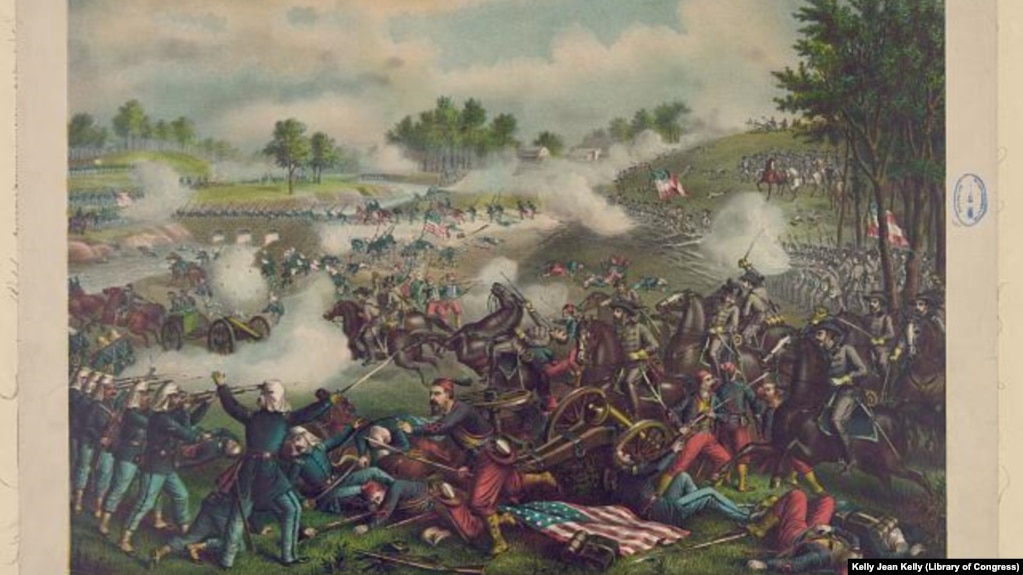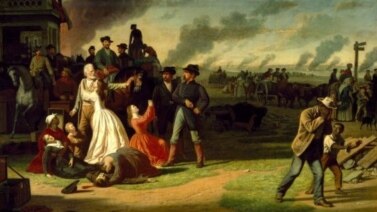
From VOA Learning English, this is The Making of a Nation.
I’m Kelly Jean Kelly.
And I’m Christopher Cruise.
Within the first few weeks of the Civil War, the Confederate Congress decided to move the capital from Montgomery, Alabama to Richmond, Virginia. The lawmakers believed Virginia would be an important battlefield in the war.
Many northerners wanted Union forces to seize the new Confederate capital and quickly end the rebellion. Pro-union newspapers took up the cry, "On to Richmond!" Most Union soldiers were not yet trained to fight. They were volunteers who knew little about war. But public pressure forced the Union army to act.
On the afternoon of July 16, 1861, about 35,000 Union troops marched out of Washington, DC. General Irvin McDowell led them toward a Virginia town where two railroad lines crossed.
The crossing was called Manassas Junction. If the Union forces could seize Manassas, they could move over land to the city of Richmond.
It was a hot day, and the road was dusty. The march was not well organized, and the men traveled slowly. They stopped at every stream to drink and wash the dust from their faces. Some of the soldiers left the road to pick fruits and berries from bushes along the way.
It took the Union soldiers four days to travel the 45 kilometers to the town of Centreville, Virginia. A stream called Bull Run lay beyond the town. The Confederate Army was waiting there.
The forces of General Pierre Beauregard had only 22,000 soldiers. But Confederate spies had warned him that McDowell would attack. So he asked that another nearby Confederate force, led by General Joe Johnston, help him defend the territory.
The First Battle of Bull Run, also called First Manassas, started the next morning -- Sunday, July 21.
In the first few hours of the battle, Union forces were winning. They attacked with artillery and pushed the Confederate forces back. Some of the southern soldiers began to run.
One Confederate officer, trying to prevent his troops from moving back, pointed to a group led by General T. J. Jackson of Virginia. "Look!" he shouted. "There is Jackson, standing like a stone wall! Rally behind the Virginians!"
The fighting was fierce. The air was full of flying bullets. A newspaper reporter wrote the whole valley was boiling with dust and smoke. A Confederate soldier told his friend, "Them Yankees are just marching up and being shot to hell.”
Neither side would give up. Then, a large group of additional Confederate soldiers — General Johnston’s men — arrived by train and joined the fight. Suddenly, Union soldiers stopped fighting and began pulling back. General McDowell and his officers tried to stop the retreat but failed. Their men wanted no more fighting.
The fleeing Union soldiers threw down their guns and equipment, thinking only of escape. Many kept running until they reached Washington.
It was a bitter defeat. But it made the North recognize the need for a real army -- one trained and equipped for a long war.
I’m Kelly Jean Kelly.
And I’m Christopher Cruise.
This is The Making of a Nation from VOA Learning English.
Frank Beardsley and Kelly Jean Kelly wrote this report from Washington.
Words in This Story
junction – n. a place where roads or railroad lines come together Yankees; n. soldiers who fought on the side of the northern states
rally – v. gather as a group
equipped – adj. prepared
Now it's your turn to use these Words in This Story. In the comments section, write a sentence using one of these words, and we will provide feedback on your use of vocabulary and grammar.
